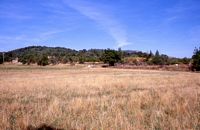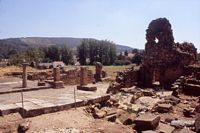
Figure 11: View of the south-eastern side of Ammaia from the lower (palaeo-)valley located here
This final part of the wall circuit was easier to map. We can probably locate the southern corner of the town wall in a field south of the national road (no. 359) to Portalegre. The surface scatter of pottery and small building materials is quite well delineated here and a concentration of the latter (especially brick and tile) even suggests the precise location of another tower compound. In a northern direction from this point, the wall circuit again (also see the situation on the north-western side of town) delimited a small valley around a still active tributary of the Rio Sever (Fig. 11). Again it seems that the Romans avoided this wet and unstable area when designing the town limits. This former wall circuit becomes more and more visible at surface level in the direction of the excavated 'porta sul', first as a kind of recent terrace wall (c.2m wide) with many granite spolia and rubble, further to the north as still standing walls of the Roman and later urban defences. The so-called 'porta sul' or southern gate (Fig. 12) now consists of the well-preserved remains of two round towers, which defend a c.6m wide monumental entrance of the town (Note 6), where a street paved with neatly cut blocks of granite opens into a porticoed square (Note 7).

Figure 11: View of the south-eastern side of Ammaia from the lower (palaeo-)valley located here

Figure 12: Excavated remains of the so-called 'porta sul' or southern gate
Immediately north of the gate compound, the original Roman town wall is still visible over a length of a few metres. Although it is wider here (1.95m), its construction with ashlar blocks and mortar binding is nearly identical to that observed in the excavation sector near the museum (see 4.1). Further to the north-east the ruins of the original Roman city walls give way to much thinner and less well-constructed post-Roman walling, suggesting an interesting continuity of occupation within this sector. The standing in situ structures soon make way for a simple terrace wall full of spolia, again delimiting the wet and lower lying valley grounds to the east. The trace of the former circuit can, however, still be seen, as well as some variations in its alignment, imposed on the builders of the city wall because of the state of the terrain. They clearly chose to build on the bedrock, which resulted in a locally more sinuous trace, before reaching the north-eastern corner of town and the starting point of this description.
© Internet Archaeology/Author(s)
University of York legal statements | Terms and Conditions
| Last updated: Mon Nov 21 2005